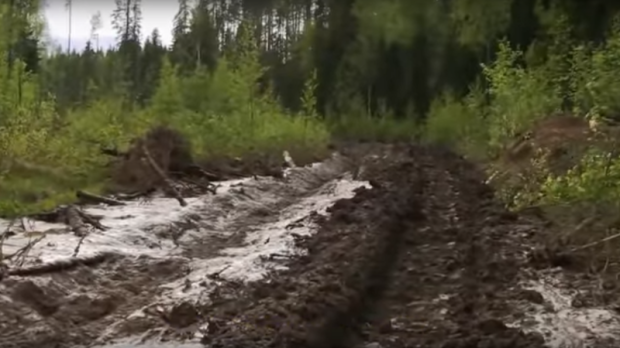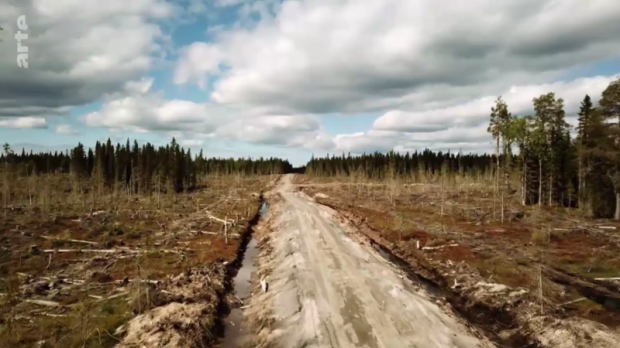For their recent ARTE documentary about FSC, journalists Manfred Ladwig and Thomas Reutter travel to Russia. FSC-certified forest in Russia covers an area that together is larger than Denmark.
The journalists meet Vieln Lupachik and Thomas Henningsen of Greenpeace. They take a film using a drone of the Dvinsky Forest in Arkhangelsk Oblast near the White Sea. They see large areas of clearcut forest, certified as well managed under the FSC system.

“Here in Russia, FSC started as a good idea, but has ended up being really detrimental,” Henningsen says. “Companies hide behind the FSC label.”
In 2014, Greenpeace put out a report titled, “FSC in Russia: Certifying the Destruction of Intact Forest Landscapes”. The report found that,
The FSC is failing to distinguish good forest management practices from the typical model of unsustainable forest exploitation widely employed in intact boreal, or taiga, forests. It is therefore failing in its mission to be a tool for forest protection.
The report was one of a series produced by Greenpeace, under the theme, “Working together to improve FSC”. Earlier this year, Greenpeace left FSC.
Clearcutting the last primary forests
Henningsen points out that the last primary forests are being destroyed, “with the FSC label”.
The companies can clearcut an area of forest covering the equivalent of fifty football fields.
“How do you feel when you see such a clearcut?” Ladwig and Reutter ask Kim Carstensen, FSC’s director general. Carstensen, predictably enough, sees nothing wrong with clearcuts:
“Have you ever seen a clearcut ten years after? Did you ever see how it actually grows again and how you actually have forest again? How this area is not dead? This area actually, maybe not with exactly the same values, but actually grows back into forest that is managed and valuable for people and for nature.”
Henningsen takes Ladwig and Reutter to an area of forest that was clearcut five or six years ago. “It will take centuries to become a forest again,” Henningsen says.
Henningsen looks at a log pile. The logs are small, even though they are from trees that had grown for 60 or 70 years. Too small for the timber sector, the logs will be pulped and made into paper or cardboard. Many of the products main from the primary forest are disposable: toilet paper, tissues, and packaging.
FSC certified logging is no better than business as usual
A German-Russian science team is carrying out research into whether the forest in FSC-certified concessions in the taiga is healthier than in logging concessions not certified by FSC.
Professor Pierre Ibisch works at the college for sustainable development in Eberswalde, Germany. He is leading the research team.
The loss of trees isn’t the only damage caused by the timber industry when it logs the forest. Heavy equipment compresses the soil.
Ibisch points out that,
“These things would never happen in this ecosystem. Compressed soil means that water cannot drain, and trees cannot grow as well as they otherwise would, or cannot grow at all. It is definitely damage. Changes to the soil are among the most important damages caused by logging.”

The researchers compare areas logged in accordance with FSC’s standards, with non-certified logging areas. They determine the ages of the trees, because the more older trees that remain standing, the healthier the forest is.
They also measure the temperature. In an intact forest, the trees can buffer changes in the temperature. In a disturbed forest, temperature extremes have a greater impact.
The researchers aim to answer the question, do FSC standards lead to better protected forests?
Carstensen tells Ladwig and Reutter that,
“We are very interested in the results of the study of Professor Ibisch, and we have invited him to come here and present that to us, because we would like to learn. As we always want to learn from research.”
The research team present their preliminary results at the University of Arkhangelsk. Professor Ibisch says,
“The FSC needs to attack the problems here, and then eliminate the problems from the roots in order to achieve a better situation of the forest. And the spatial analysis just seen, the main message is there is no change in the spatial design of the forest use, we still have these chequerboards of the large scale clearcuts.”
Shortly after the presentation, a logging company withdraws its permission to allow Ladwig and Reutter to film in their concession. A manager of another logging company worries that the study could damage the Russian timber industry.
FSC certification of clearcuts makes things worse
Ladwig and Reutter interview remote sensing scientist Matthew Hansen at the University of Maryland in the USA. Satellite images of the taiga show no difference between FSC certified logging operations and those not certified under the FSC system.

Hansen says,
“If we go over to the Arkhangelsk region, you can see very clearly the clearcuts in the FSC landscape. The idea that sustainable logging is represented through large scale clearcuts is difficult to understand. And it’s that perversion that really bothers me, both as a citizen and as a scientist.
“If there is a programme to do sustainable logging, but in fact the facts on the ground say it’s actually in opposition to sustainability, it has worse effects than being forthright to begin with. So if you’re fully transparent, people know what they’re buying and they sign up for that. But if you’re misleading them, and they think that they are doing a sustainable thing with your product, and in fact they’re not, then this is of course a worse case.”
This is the ninth post in a series based on ARTE’s documentary about FSC: “The exploitation of primary forests: Can an ecolabel stop the forest industry?”
The documentary is available here (and in German here).

More details on FSC certified logging in Arkhangelsk:
http://www.forestforum.ru/viewtopic.php?f=28&t=21642
(Who Destroys the Last Taiga Wilderness in Arkhangelsk Oblast)
Thanks Alexey! The satellite images really are shocking: